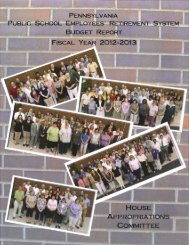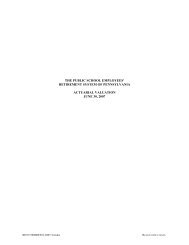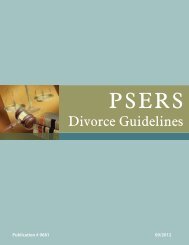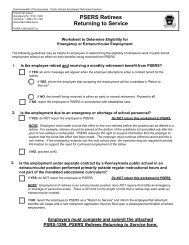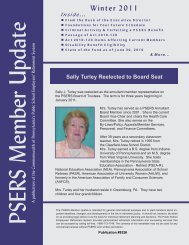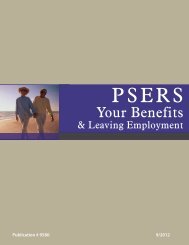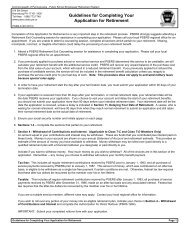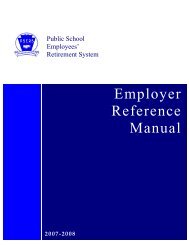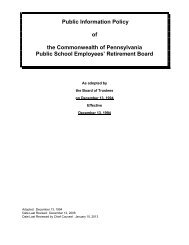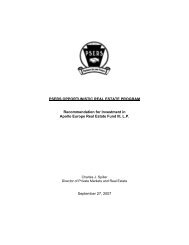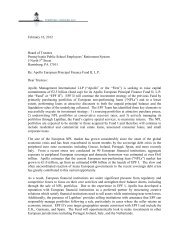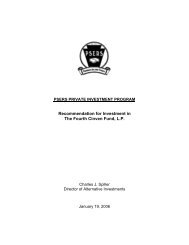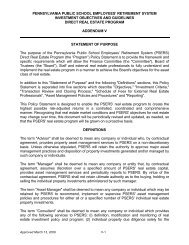a complete copy of the 2012 CAFR Report! - PSERs
a complete copy of the 2012 CAFR Report! - PSERs
a complete copy of the 2012 CAFR Report! - PSERs
You also want an ePaper? Increase the reach of your titles
YUMPU automatically turns print PDFs into web optimized ePapers that Google loves.
Notes to Financial Statements (continued)<br />
FINANCIAL SECTION<br />
PSERS members whose membership started prior to July 1, 2011:<br />
Membership Class T-C Active Members hired before July 22, 1983 5.25%<br />
Membership Class T-C Active Members hired on or after July 22, 1983 6.25%<br />
Membership Class T-D Active Members hired before July 22, 1983 6.50%<br />
Membership Class T-D Active Members hired on or after July 22, 1983 7.50%<br />
PSERS members whose membership started on or after July 1, 2011 (Act 120 members):<br />
Membership Class T-E* 7.50%<br />
Membership Class T-F** 10.30%<br />
* Shared risk program could cause future contribution rates to fluctuate between 7.5% and 9.5%<br />
** Shared risk program could cause future contribution rates to fluctuate between 10.3% and 12.3%<br />
years <strong>of</strong> credited service. For members whose membership<br />
started prior to July 1, 2011, in most cases after completion<br />
<strong>of</strong> five years <strong>of</strong> service, a member’s right to <strong>the</strong> defined<br />
benefits is vested and early retirement benefits may be<br />
elected. For Class T-E and Class T-F members, <strong>the</strong> right to<br />
benefits is vested after ten years <strong>of</strong> service. Under certain<br />
features <strong>of</strong> <strong>the</strong> System, active members may purchase<br />
credit for various types <strong>of</strong> school and non-school service<br />
on a lump-sum, installment purchase basis, or through an<br />
actuarially calculated benefit reduction. Class T-E and<br />
Class T-F members must purchase Non Qualifying Part<br />
Time service and most o<strong>the</strong>r types <strong>of</strong> non-school or nonstate<br />
service credit at full actuarial cost.<br />
In addition to regular retirement benefits, <strong>the</strong> System<br />
also provides for disability retirement benefits and death<br />
benefits. Participants are eligible for disability retirement<br />
benefits after completion <strong>of</strong> five years <strong>of</strong> credited service.<br />
Such benefits are generally equal to 2% or 2.5%, depending<br />
upon membership class, <strong>of</strong> <strong>the</strong> member’s final average<br />
salary (as defined in <strong>the</strong> Code) multiplied by <strong>the</strong> number<br />
<strong>of</strong> years <strong>of</strong> credited service, but not less than one-third <strong>of</strong><br />
such salary nor greater than <strong>the</strong> benefit <strong>the</strong> member would<br />
have had at normal retirement age. Members over normal<br />
retirement age may apply for disability benefits. Certain<br />
exceptions apply to normal disability retirements.<br />
Death benefits are payable upon <strong>the</strong> death <strong>of</strong> an active<br />
member who has reached age 62 or who has at least<br />
five years <strong>of</strong> credited service (ten years for Class T-E<br />
and Class T-F members). Such benefits are actuarially<br />
equivalent to <strong>the</strong> benefit that would have been effective if<br />
<strong>the</strong> member had retired on <strong>the</strong> day before death. Benefits<br />
may be distributed for a deceased member by a nonspouse<br />
beneficiary via a direct trustee-to-trustee transfer to an<br />
Individual Retirement Account (IRA), which is treated as<br />
an inherited account.<br />
Members with credited service in <strong>the</strong> Commonwealth<br />
<strong>of</strong> Pennsylvania State Employees’ Retirement System<br />
(SERS) may elect to transfer service with <strong>the</strong> Public School<br />
Employees’ Retirement System upon commencement<br />
<strong>of</strong> employment in <strong>the</strong> public school system. Similarly, a<br />
member with credited service in <strong>the</strong> System may transfer<br />
such service with SERS upon becoming a member <strong>of</strong> that<br />
system.<br />
All members are fully vested in <strong>the</strong>ir individual balance in<br />
<strong>the</strong> Members’ Savings Account which is described in Note<br />
3. All non-vested members may receive a refund <strong>of</strong> <strong>the</strong>ir<br />
individual balance <strong>of</strong> member contributions and interest<br />
from <strong>the</strong> Members’ Savings Account upon termination<br />
<strong>of</strong> public school employment. Vested members who<br />
enrolled prior to July 1, 2011 may elect to receive a return<br />
<strong>of</strong> <strong>the</strong>ir accumulated contributions and interest upon <strong>the</strong>ir<br />
retirement. Vested Class T-E and Class T-F members cannot<br />
withdraw <strong>the</strong>ir individual balance from <strong>the</strong> Members’<br />
Savings Account upon <strong>the</strong>ir retirement.<br />
ii. Contributions<br />
The contribution policy is set by <strong>the</strong> Code and requires<br />
contributions by active members, employers, and <strong>the</strong><br />
Commonwealth. The System’s funding policy provides<br />
for periodic employer and Commonwealth contributions<br />
at actuarially determined rates, expressed as a percentage<br />
<strong>of</strong> annual covered payroll, such that <strong>the</strong>y, along with<br />
employee contributions and an actuarially determined rate<br />
<strong>of</strong> investment return, are adequate to accumulate assets to<br />
pay retirement benefits when due. Level percentage <strong>of</strong><br />
payroll employer contribution rates are determined using<br />
<strong>the</strong> entry age normal actuarial funding method. This<br />
method determines <strong>the</strong> amount <strong>of</strong> contributions necessary<br />
to (1) fully fund all current costs, (also known as normal<br />
cost), which represents <strong>the</strong> estimated amount necessary to<br />
pay for <strong>the</strong> benefits earned by <strong>the</strong> employees during <strong>the</strong><br />
current service year; and (2) liquidate <strong>the</strong> prior service<br />
cost for service earned prior to <strong>the</strong> current service year and<br />
subsequent benefit increases, which represents <strong>the</strong> amount<br />
necessary to fund accrued liabilities over <strong>the</strong> appropriate<br />
amortization periods.<br />
PAGE 41



